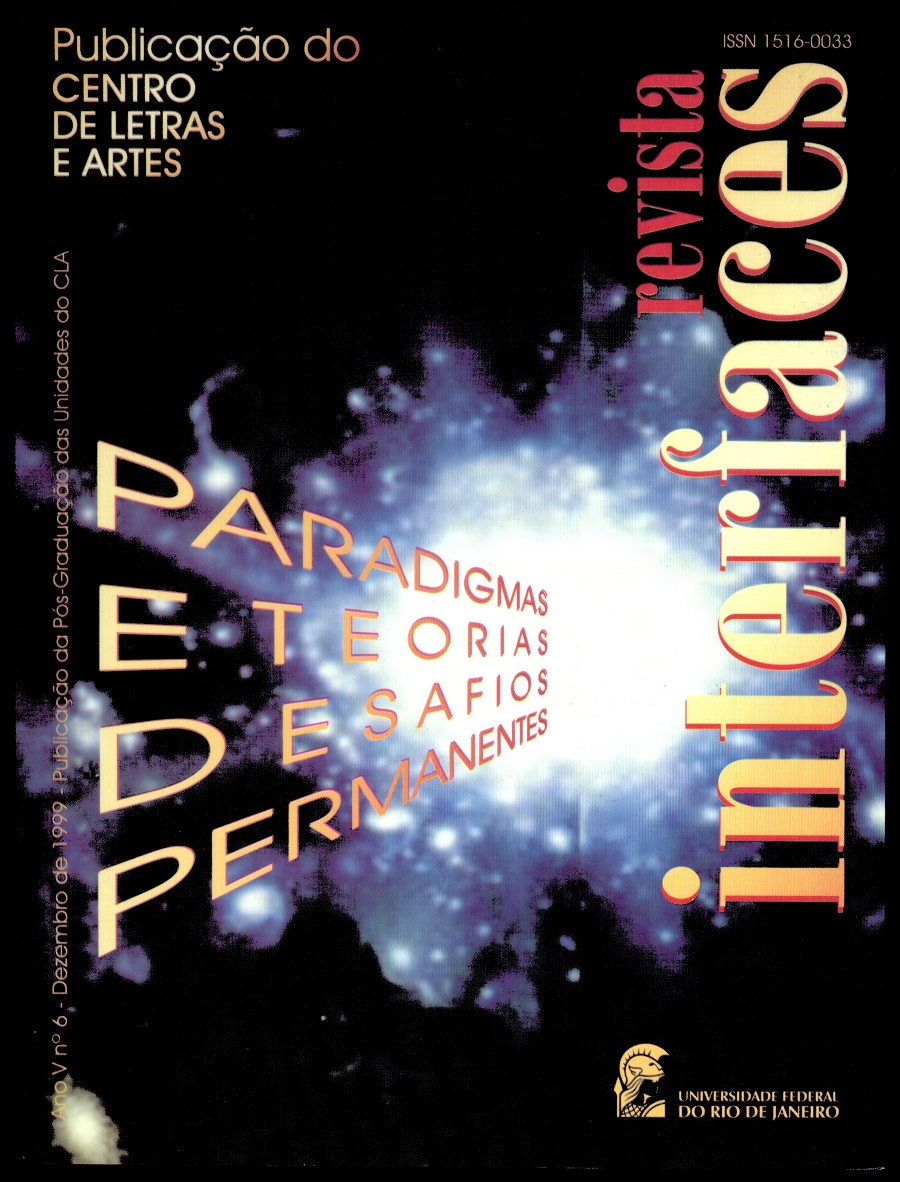Linguística e Comunicação: os Elementos de um Paradigma
Palavras-chave:
Teoria geral da comunicação, SociolinguísticaResumo
In this article I argue in favor of a theory of communication that encompasses interindividual sociocultural differences in the communicative language behavior into a general theory of communication. In this sense I review some of the basic concepts of the Interactional Sociolinguistics and discuss its model of communication. Key concepts here are: interactive process, situated speech, contextualization cues, involvement in discourse, self, face, cooperation and language problems.Referências
AKINNASO, F. NIYI & AJIROTUTU, C. S. (1982) Performance and ethnic style in job interviews. IN: John Gumperz. Language and Social Identity. Cambridge (MA): Cambridge University Press, 1982b.
AUSTIN, J. (1962) How to do things with words. Cambridge, M.A.: Harvard University Press.
BANKS, S. P., GE, G., BAKER, J. (1991) Intercultural Encounters and Miscommu-nication. IN: Coupland,G.& wiemann.Miscommunication and problematic talk.Newbury Park,London, New deli: Sage Publications.
BATESON G.(1972) Uma teoria para fantasia e brincadeira. IN: Cadernos IPUB. Instituto de Psiquiatria da Universidade Federal do Rio de Janeiro, v. 1, n° 5,p. 25 - 37, 1997 [1972].
ERICKSON, F. (1979) Talking down: some cultural sources of miscommunication in interracial interviews. IN: A. Wolfgang (ed.) Nonverbal communication. New York: Academic Press, p.99-126.
_______. (1982) Money tree,lasagna bush,salt and pepper:Social Construction of topical cohesion in a conversation among Italian-Americans. IN: D. Tannen (ed.). Analysing Discourse:Text and talk. Washington, DC: Georgetown Univ. Press,p.43-70.
ERICKSON,F. & SCHULTZ,J.J. (1982)The counselor as gatekeeper: social interaction in interviews. New York: Academic Press.
GOFFMAN. E. (1967) On face work. IN: Interactional ritual. New York: Anchor Books.
_______.(1974) Frame ana/ys/s.New York: Harper e Row.
_______. (1975 [1959]) A representação do eu na vida cotidiana. Petrópolis: Vozes.
_______. (1981} Footing. IN: Forms of talk. Philadelphia: University of Pennsylvania Press,p. 124 - 59.
GUMPERZ, J. J. (1982a) Discourse Strategies. Cambridge: Cambridge University Press.
_______. (1982b) Language and Social Identity. Cambridge (MA): Cambridge University Press.
_______. (1992) Contextualizationandunderstanding.IN:A.Duranti &C.Goodwin (eds.) Rethinking context. New York: Cambridge University Press.
GUMPERZ, J.J., AULAKH, G. & KALTMAN,H. (1982) Thematic structure and progresión in discourse. IN: J.Gumperz (ed.) Language andSocial Identify.Cambridge (MA):Cambridge University Press.
GUMPERZ, J, & COOK-GUMPERZ, J. (1982) Introduction: language and the communication of social identity. IN: John Gumperz. Language and Social Identity. Cambridge (MA): Cambridge University Press, 1982b.
HYMES, D. (1974) Foundations in sociolinguistics: An ethnographic approach Philadelphia: Univ. of Pennsylvania Press.
LABOV, W. (1973) Language in the inner City. Philadelphia: Univ. of Pennsylvania Press.
MALTZ, D. N. & BORKER, R. A (1982). A cultural approach to male-female miscommunication. IN: J. J. Gumperz (ed.), ) Language and Social Identity. Cambridge (MA): Cambridge University Press.
MISHRA, A. (1982) Discovering connections. IN: John Gumperz. Language and Social Identify. Cambridge (MA): Cambridge University Press, 1982b.
MOITA LOPES, L.P. (1986) Discourse analysis and syllabus design: an approach to the teaching of reading. Tese de PhD; University of London - Institute of Education. London,.
MOITA LOPES, L.P. (1994) Pesquisa ínterpretativista em Lingüística Aplicada: a linguagem como condição e solução. IN: D.E.L.T.A, vol.10, n°12, p.329-338.
PHILIPS, S. (1972) Participant structures and communicative competence: Warm springs children in community and classroom. IN: C. Cazden, D. Hymes & V. John (eds.) Functions of language in the classroom. New York: Teachers College Press,p. 370-394.
QUENTAL, L. (1997) O ato deinterpretar:um estudo de sociolingüística interadonal. IN: Cadernos IPUB.Instituto de Psiquiatria da Universidade Federal do Rio de Janeiro, v. 1,n° 5, p. 79 - 106, 1997.
RIBEIRO, B. T. (1997) Análise de enquadres em uma entrevista psiquiátrica. IN: Cadernos IPUB. Instituto de Psiquiatria da Universidade Federal do Rio de Janeiro, v. 1,n° 5, p.39 - 78, 1997.
RUMELHART,D. E. (1980) Schemata:The Building Blocks of Cognition. In:R. J. Spiro et al. (eds.),p. 33- 58.
SCHIFFRIN, D. (1994) Approaches to discourse. Cambridge, MA: Blackwell.
SCOLLON, R. & SCOLLON, S. W. (1997(1995]) Intercultural Communication. Cambridge (MA): Blackwell,.
SEARLE, J. (1975) Indirect speech acts.In P. Cole & J.Morgan (eds.) Syntax and semantics. Vol. 3: Speech Acts. New York: Academic Press, p.59-82.
TANNEN, D. (1984) Conversational style: Analysing talk among friends. Norwood (NJ): Ablex,.
______. (1989) Involvement in discourse.IN:Talking Voices. Cambridge,MA:Cambridge University Press.
_______. (1994) Gender and Discourse.. New York: Oxford University Press.
TANNEN, D., WALLAT, C. (1993) Interactive frames and knowledge schemas in interaction: examples from a medical examination/interview. IN: D.Tannen, (ed.).Framing in discourse. New York:Oxford University Press,p. 57 - 76.
WALTZLAWICK, P„BEAVIN, J. & JACKSON, D. (1967) The pragmatics of human communication. New York: Norton.
YOUNG, L. W. L. (1982) Inscrutability revisited. IN: J. J. Gumperz (ed.). ) Language and Social Identity. Cambridge (MA): Cambridge University Press.


